Croton Point Campground, Croton-on-Hudson, New York
Dan will provide justice for his people as one of the tribes of Israel. Dan will be a serpent by the roadside, a viper along the path, that bites the horse’s heels so that its rider tumbles backward. ~ Genesis 49:16-17 ‘Dan the judge’ – While Dan (son #5) was to provide justice (his name even means ‘judge’), his tribe will choose treachery. During the time of the judges, the first major practice of idolatry happened in the tribe of Dan (Judges 18). When the Israelites failed to run off all those living in the Promised Land like they were told by God, some of them became subject to the whims of those people, so that by the time Judges 18 rolls around, the tribe of Dan had no land of their own. A group of them happened upon a house who was paying a Levite priest (who was using pagan idols) to pray for them and inquire of God (as well as other gods) on their behalf. These same men were scouts, sent out to find land that could be easily obtained by the Tribe. And they did. And the tribe came together with 600 fighting men and destroyed a town called Laish and made it their own – along with practicing idol worship. Samson comes from the Tribe of Dan. Here is another case of God’s people not following through with what God called them to do, and reaping the consequences. Their first wrong step was followed by another, and another….. until they became a tribe of mostly selfish, prideful people. And not prideful in a good way. They believed they could do what they wanted, when they wanted. Hence, the attitude of Samson. Samson was supposed to live for God, but he became prideful instead; and because of that, he reaped the consequences, until he was brought down. Once he was at his lowest, he finally turned to God and repented, and with that, was then able to bring down the house (so to speak). Samson’s life demonstrates to us how God can use even those who turn from Him to accomplish His sovereign Plan, and His willingness to Forgive when we repent. I know this is already long, but one more thing I discovered about the Tribe of Dan – in I Chronicles 4-7, there’s no mention of them, nor in Revelation 7, where all the tribes are mentioned in the end-times tribulation except for Dan. No one is sure why, but commentators have come up a few possible reasons: They allowed themselves to become assimilated into the Phoenicians (think, the city of Tyre), and/or their long history of embracing idolatry and immorality caused them to be left out.

By the way, the boundaries for each tribe were set up when, “Joshua then cast lots for them in Shiloh, in the presence of the LORD, and there he distributed the land to the Israelites according to their tribal divisions.” ~ Joshua 18:10
NOTE: Nearly two weeks after we visited New York City, I finally had the internet service to put the post together. On occasion (usually between 5-8am), I had some service, but that’s it. It’s been very frustrating not having service – including phone calls and oftentimes texts. It’s terrible not being able to connect with friends and family, or look anything up. That being said, the following two posts are extremely long, not entirely because of pictures, but information as well. So those of you who claim to read every word, be prepared for the long haul. 😊
New York, New York, it’s a wonderful town! The Bronx is up and the Battery’s down. The people ride in a hole in the ground. New York, New York, it’s a wonderful town!
Did you recognize the song from “On the Town”, the 1949 movie starring Gene Kelly and Frank Sinatra? This portion was playing in my head for two days. 😊
We had a wonderful time in NYC! I wasn’t sure I would – crowds and all – but it wasn’t bad at all. Trains, subways, stations, and most of the city’s streets we covered were clean and relatively free of any issues. Except for the two naked people we encountered. Yes. Naked. Well, the 40-50+ pudgy woman was wearing a thong, but that’s it. And I didn’t actually see the man myself, but if I’d been taller, I’m certain I would’ve. I did however see all the commotion the guy caused as police cars screamed in from every direction. I’m thinking it’s because he was acting wild. Law enforcement can’t be too cautious these days.
And that’s the most excitement we encountered, which was fine by us.
It was a very short drive from our campground to the parking lot of the train station, which is how we got from Croton-on-Hudson to Grand Central Station. It’s a 6:30am direct express route that took us about fifty minutes. There were quite a few dozing people on the train to the “City that never sleeps”. It’s good they got their naps in. One guy serenaded us the entire way with his deep snores. 😊 The train ride is above ground, and has large windows so there was plenty to see along the way – the Hudson River on one side occasionally sprouting towering cliffs, and buildings and towns on the other.
It took some time for Blaine to get his bearings and figure out the subway system, but fortunately, there was a guy in a business suit who was very helpful in getting us started.
Because we visited so many places, I’m going to allow various sources to ‘write’ most of the post the next two days. If you want to learn about these places, read them. If not, just skim through the pictures. 😊
1. First up – NYC Subway Facts for 2019 ridership:
Average weekday subway ridership: 5.5 million
Our annual ridership: 1.698 billion
All-time ridership record: 2.067 billion passengers, in 1946
Number of subway cars: 6,684
Subway car mileage: The fleet traveled 365 million miles in 2019
Number of miles traveled by an average subway car between repairs: In 1982: 7,145 In 2019: 127,743
Number of stations: 472
Number of stations in original Manhattan system: 28 (opened in 1904)
Most station platforms are between 525 and 660 feet long.
Highest station above ground: Smith-9 St in Brooklyn, 88 feet above street level.
Deepest station:191 St in Manhattan, 180 feet below street level.
The subway system now has more than 665 mainline track miles.
Laid end to end, NYC Transit train tracks would stretch from New York City to Chicago.
The subway system opened on October 27, 1904 with 28 stations in Manhattan; there are now 472 stations, most of which were built by 1940.
The worst subway accident in the city’s history happened in 1918 when a conductor who was filling in for a striking employee lost control of his train while entering a tunnel on Brooklyn’s Malbone Street. The resulting crash killed 97 people and injured over 200 others.
In 1916 a worker excavating under the East River survived being sucked through the river and shot up into the air after the pressurized tunnel he was digging cracked.
The first female subway conductor was hired in 1917.
The MTA will email or fax you a “late letter” of explanation if a train delay makes you late for work.
The first air-conditioned subway cars were rolled out in May of 1967, but all trains didn’t have a/c until 1993 (the 7 train was the last to cool off). ~ new.mta.info
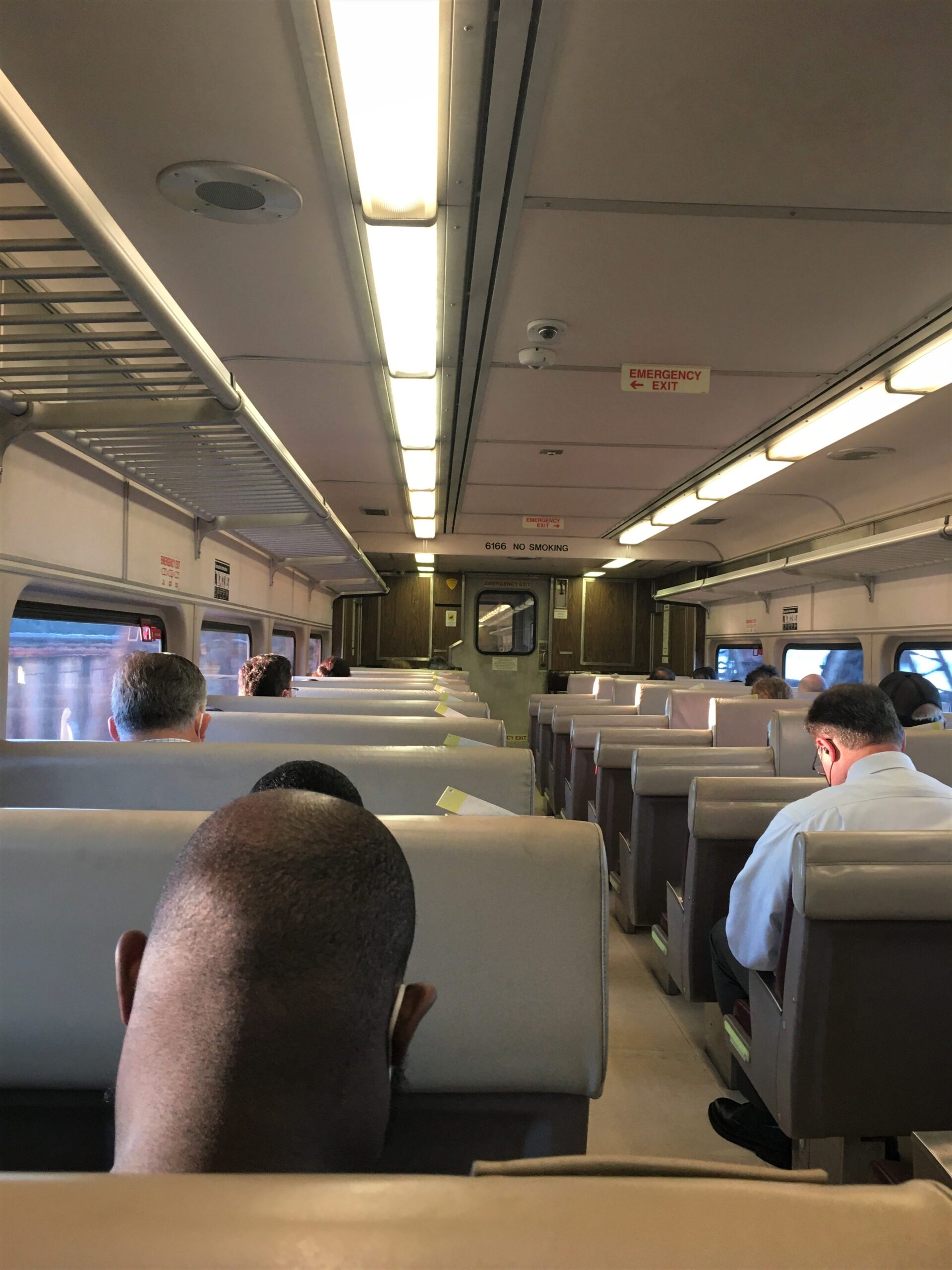

By the time we entered the lobby of Grand Central Terminal (They’re very specific – Terminal, not station! Station, as you can read below, is reserved for the US Post Office), it was 7:30. We took just a few minutes to ooh and ahh over the construction, before heading out to our hotel, Homewood Suites – a 20 minute, one mile walk. That needed to be our first stop, because they offer to hold your bags until you can actually check in. Isn’t that wonderful of them?!?
2. Grand Central Terminal

You can’t tell, but the ceiling is painted with stars (which have tiny little lights )
and the zodiac pictures, etc. are drawn in with what looks like gold.

You can’t tell how intricately these chandeliers are designed!

I discovered it while I was looking around waiting for Blaine to take the light picture. : )
Opened to the public on February 2, 1913, Grand Central is a world-famous landmark and transportation hub in Midtown Manhattan. Its rich history is a story of immense wealth and great engineering, but also of survival and rebirth.
Grand Central Terminal goes by many names, including Grand Central, the Terminal, and GCT. Just don’t call us “Grand Central Station”—that refers to the US Post Office down the street or the subway station below.
The building covers a total area of 48 acres and consists of 44 platforms, the most number of platforms of any railway station in the world!
To say that constructing Grand Central Terminal was a massive project is an understatement. It was to become the biggest railway station in the world at the time and it took a lot of manpower to get things done.
A total of 10,000 construction workers were hired to demolish the old Grand Central Station, excavate the site, and for the new building and tracks to be constructed.
After the old station was demolished, 3.2 million cubic yards (2,400,000 cubic meters) of soil were excavated at a rate of 1,000 cubic yards (760 cubic meters) per day.
Construction took almost 10 years and was fully completed when the new terminal was opened on February 2, 1913.
With 750,000 visitors every day, Grand Central Terminal is one of the most-visited destinations in New York City, second only to Times Square.
The centerpiece of the Main Concourse is its celestial ceiling, which features the 12 zodiac constellations. At some point during the design, the order of the constellations was painted in reverse, with west and east flipped. The design was eventually corrected, but Orion still faces backward.
In June, 1945, renovations on the roof of the Main Concourse were completed. The mural, which had fallen victim to numerous leaks, was repaired, and a new, duplicate mural was painted. The 12 constellations are composed of thousands of gold leaf stars, with some twinkling lights dotting the sky.
If you look up at the giant zodiac on the ceiling, you’ll find a small, dark brick next to Cancer, the crab. This brick is a reminder of what the station’s ceiling looked like before it was cleaned during the 1998 restoration project. According to John Canning Company, which cleaned and restored the mural, the brick represents the two-inch thick grime covering the ceiling, caused by decades of air pollution. ~ comprised from several websites
Our walk to the hotel . . . .

Looks like Uber hasn’t taken over the taxi service – – yet. : )




This is the door to the Polish Consulate!
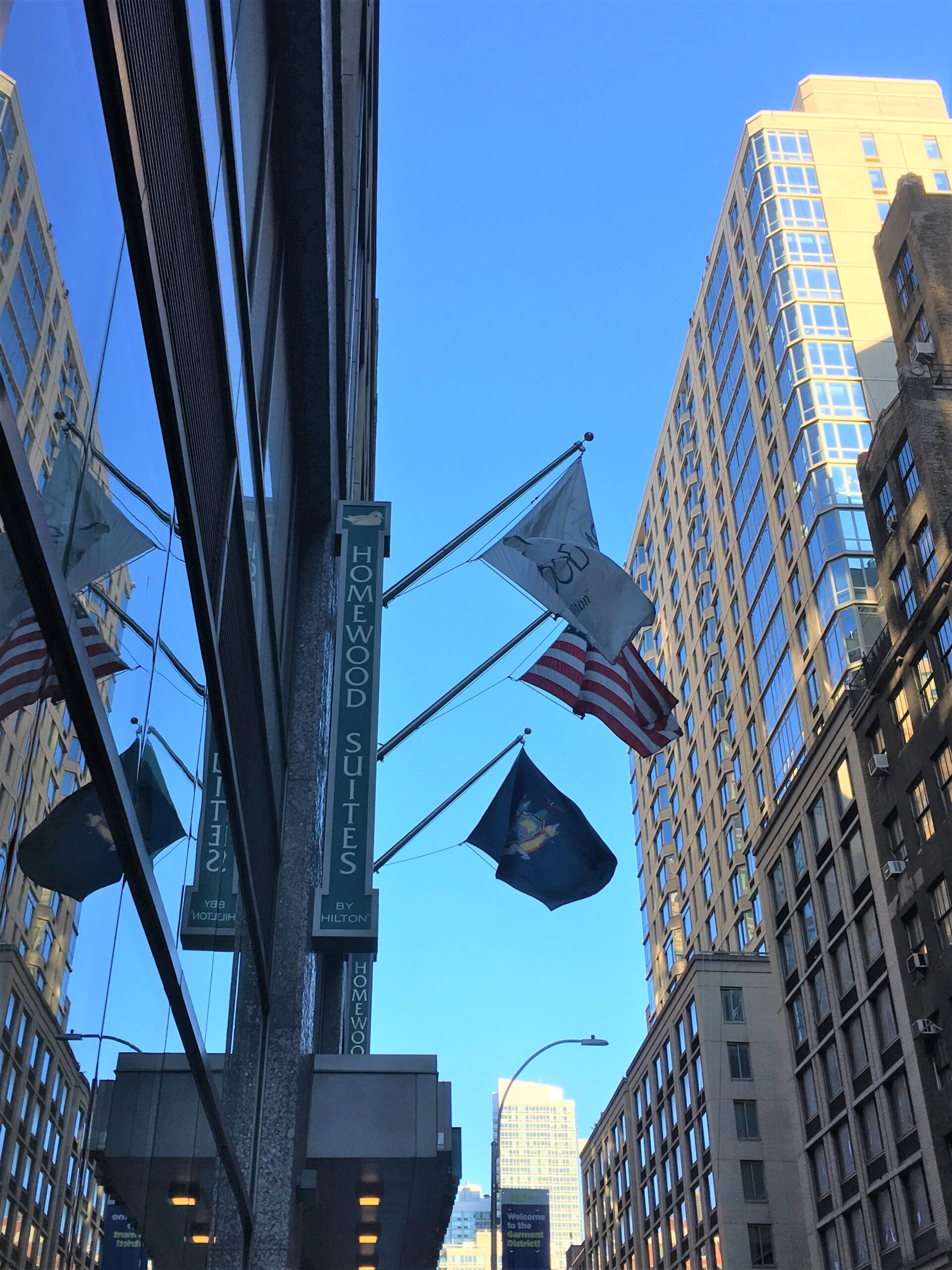
3. Hotel to Subway – I don’t have pictures of this walk we made to get to the subway station. The clerk at the hotel gave us directions, but then as I mentioned above, we had to figure out how to actually use it. 😊 There are plenty of stairs you have to take, so it’s not suitable for those who can’t maneuver those for any reason. It’s also really warm underground. We made it to our chosen destination:
4. The Brooklyn Bridge


It’s hard to distinguish, but that circle goes around the larger support line, and right in the middle, is a door!
Can you believe someone(s) walk on that to do whatever it is they have to do?!?
There were several of these doors on either side of the bridge.


I believe the building with the green top is Trump Tower,
the tall blue one is the One World Trade Center
and the twisty-looking one is the New York by Gehry building,
which I’ll give more information on shortly.


It was built in 2010 and named after its architect.
It’s one of NYC’s tallest residential towers at 76 stories and
has a design that suggests a building rippling in the wind.
Believe it or not, the base of the building is home to New York City public school, PS 397,
which has around 500 kids between pre-kindergarten and seventh grade.
William M. “Boss” Tweed, the infamously corrupt head of New York City’s Tammany Hall political machine, latched on to the Brooklyn Bridge project from the very beginning. According to sworn testimony he gave later, he facilitated up to $65,000 in bribes to New York’s aldermen in order to win their backing for a $1.5 million bond issue. He then became a major holder of bridge stock and joined a committee charged with managing the project’s finances. Tweed allegedly hoped to skim money from the city’s bridge contracts, much as he had done with other large public works. But he was arrested in 1871 before he could fully realize his plan. It has since been estimated that Tweed and his cronies stole at least $45 million, and perhaps as much as $200 million, from the public coffers during their time in power.
At least 20 people died during the bridge’s construction.
The first fatality came in 1869 before construction had even begun. German-born John A. Roebling, who designed the bridge, was taking compass readings one afternoon when his foot was crushed between some pilings and a boat. His toes were amputated, and a few weeks later he died of tetanus. Other workers fell off the 276-foot-high towers, were hit by falling debris or succumbed to caisson disease, better known as “the bends. “No official figure exists for the number of men killed, but estimates range from 20 to over 30. Dozens more suffered debilitating injuries, including Roebling’s son Washington, who became bedridden with the bends after taking over as chief engineer from his father.It was the longest suspension bridge in the world—by far.
A few high-profile collapses in the first half of the 19th century prevented suspension bridges from immediately catching on. Undeterred, Roebling figured out how to stabilize them, largely by adding a web truss to either side of the roadway platform. He built four suspension bridges in the 1850s and 1860s, including one over the Ohio River and another near Niagara Falls. All would later be dwarfed by the Brooklyn Bridge, which, with a main span of just over 1,595 feet, was by far the longest suspension bridge in the world. It remained that way until 1903, when the nearby Williamsburg Bridge overtook it by 4.5 feet.Huge crowds gathered on May 24, 1883, to watch the bridge’s opening ceremony, which The New York Times described, in reference to Brooklyn, as “the greatest gala day in the history of that moral suburb.” President Chester A. Arthur, New York Governor (and future president) Grover Cleveland and various local politicians marched onto the bridge, accompanied by a military band and an attachment of troops. Celebratory cannon fire rang out when they reached the Manhattan-side tower. The festivities also included an hour-long fireworks display, receptions and a number of speeches. Just before midnight the bridge opened to the public, and more than 150,000 people streamed across over the next 24 hours. Not everyone was happy, however. Many Irish boycotted the ceremony because it coincided with the birthday of British monarch Queen Victoria.
A week after the opening, on Memorial Day, an estimated 20,000 people were on the bridge when a panic started, allegedly over a rumor that it was about to collapse. Twelve people were crushed to death on a narrow stairway, and others emerged bloodied and in some cases without clothes. One eyewitness described men and women “with their limbs contorted and their faces purpling in their agonized efforts to breathe.” No changes came about in the immediate aftermath of the tragedy, except that more police were stationed on the pedestrian promenade.
When the Brooklyn Bridge first opened, it cost a penny to cross by foot, 5 cents for a horse and rider and 10 cents for a horse and wagon. Farm animals were allowed at a price of 5 cents per cow and 2 cents per sheep or hog. Under pressure from civic groups and commuters, the pedestrian toll was repealed in 1891. The roadway tolls were then rescinded in 1911
At the time, the bridge connected two different cities.
Brooklyn did not become part of New York City until 1898, following a referendum that passed there by just 277 votes (out of more than 129,000 cast). Prior to the merger, it was the fourth most populous city in the country—behind only New York, Chicago and Philadelphia—with loads of manufacturing jobs, many churches, relatively low crime and good schools. ~ history.com

5. St. Paul’s Chapel – where we were refused entry. We’d read about the important role this church, built in 1766, played in 9/11 events, and that they had a museum set up, so we wanted to see it. But they wouldn’t let us in because we didn’t have a copy of our Covid vaccination record. Thank goodness it was the only place in all of NYC that we visited that asked for them! All but one place, the American Indian Museum didn’t even require masks. We were disappointed, but I figured, there’s always the internet for back up. Except I couldn’t find much information nor the pictures I was looking for. Their website says they’re an active church, and holding services, but the pictures I found after September 11, 2001 don’t show any pews. Most likely, they were removed during the restoration project fifteen years later.

After the attacks of September 11, 2001, St. Paul’s Chapel, which sits directly across the street from the World Trade Center site, suffered no physical damage.
On September 12, Lyndon Harris, then a priest on the clergy staff at Trinity and St. Paul’s, arrived at St. Paul’s Chapel expecting major damage. He was amazed to find that the church was without even a pane of glass broken. The exterior of St. Paul’s and its churchyard were covered in debris. After engineers inspected the building and pronounced it sound, cleanup began.
As recovery work started at the World Trade Center site, hundreds of rescue workers came to Lower Manhattan to search for survivors and begin sorting through the ruins. Slowly at first, rescue workers, police, and firefighters stopped by the chapel to rest and wash up. Because long, exhausting shifts prevented many workers from going home, the chapel opened its doors so that they could rest . Shortly after, an outdoor grill was fired up, and volunteers began to serve food to hungry rescue and recovery workers.
Volunteers from Seamen’s Church Institute arrived on September 15 with food, clothing, and other supplies. Labor of Love, an Episcopal relief ministry based in Asheville, North Carolina, arrived on September 21. The volunteers were all experienced in disaster relief and skilled in offering support and guidance during a crisis.
During all hours of the day and night, rescue and recovery workers staggered through the gates of the chapel. Hungry and weary, weighed down with gear, wearing boots half-melted from the fiery ash, they fell into St. Paul’s open embrace. After working grueling 12–18 hour shifts at Ground Zero, rescue and recovery workers knew that St. Paul’s was a place they could rest for a few hours before returning to the pit.
In the first three months after September 11, more than 3,000 workers passed through the chapel’s gates. Police officers, Port Authority workers, firefighters, National Guardsmen, construction and sanitation crews, engineers and technicians found their way to St. Paul’s. The recovery workers were changed by what they volunteered to do at Ground Zero, but they also were changed by the ministry offered to them by St. Paul’s and its volunteers. ~ trinitywallstreet.org

It looks to me like a lot of cleanup has already begun, but I’m not sure.
Still a sobering picture . . . .

I did happen across this article written by the architectural firm who did some restoration work on the chapel in 2016.

Simple and beautiful! Since we didn’t go in, I can only assume that the information posted along the wall
under the balconies is about 9/11, but I can’t be sure. It may also be church history.
Known as the “little chapel that stood,” St. Paul’s Chapel has endured over 250 years of New York City’s history, making it the oldest public building in continuous use in the city. St. Paul’s Chapel was built as a “chapel-of-ease” for those in 18th Century New York City who deemed the walk to Trinity Church on Wall Street too far. When the chapel was finished in 1766, it stood as the tallest building in the city. Ten years later, the chapel survived the Great New York City Fire, a result of a Revolutionary War battle that burned a quarter of the city. At the end of the war, on the day George Washington was inaugurated as the first president of the new United States, Washington and members of Congress worshiped at St. Paul’s Chapel. Washington continued to attend services at St. Paul’s for the two years in which New York City was the nation’s capital.
More than two centuries later, St. Paul’s Chapel escaped another tragedy virtually untouched. On September 11, 2001, during the terrorist attacks, the chapel, which sat opposite the east side of the World Trade Center, became a place of refuge and recovery for rescue workers and volunteers. In the following weeks, it served as an impromptu memorial site for the victims.
Although St. Paul’s Chapel survived 9/11 with only one broken window, centuries of use will take a toll on a building; as one of the best examples of late Georgian architecture in New York City, the chapel needed to be restored. In 2016, EverGreene restored both the interior of the chapel as well as the 9/11 memorial at the rear of the building. EverGreene scraped, primed, and painted the original plaster walls and repaired damaged areas. After the ceiling was preserved, new plaster was injected to stabilize cracks in the walls. Artisans and craftsmen gilded the pulpit, polished the wooden altar rail, and restored the original wooden doors in the main sanctuary. Our team also restored the eight magnificent sterling silver chandeliers that hang from the ceiling. The chandeliers were removed, taken apart offsite, cleaned, and broken or missing components were repaired and replaced.
St. Paul’s Chapel continues to impact the lives of New Yorkers, as it functions as a thriving Episcopal parish on Broadway. St. Paul’s Chapel is listed on the National Register of Historic Places and recognized as a National Historic Landmark. ~evergreene.com
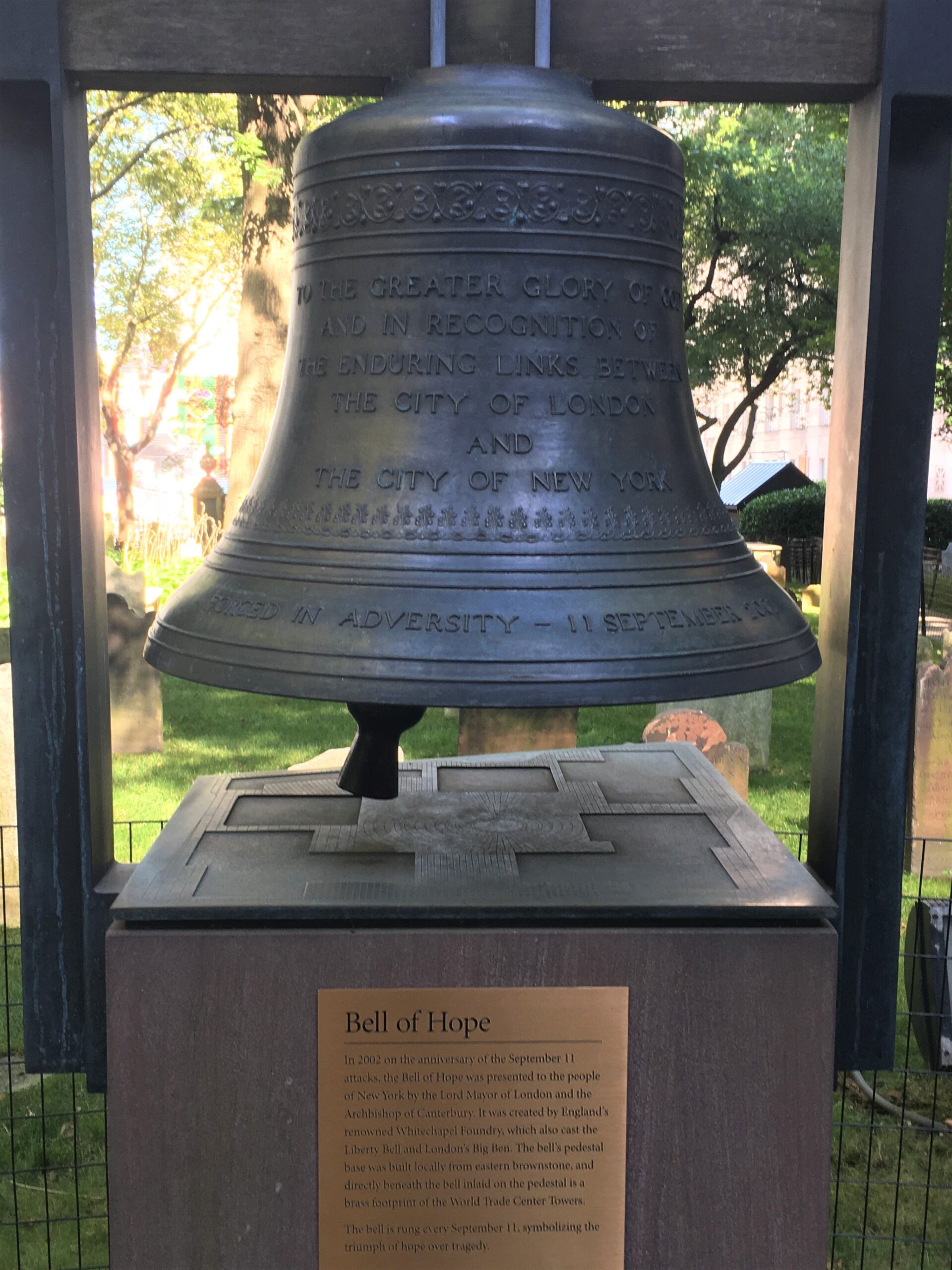


6. Walk to Wall Street – The street and some of the things on it – the New York Stock Exchange, and Trump Tower – was one of the places Blaine wanted to see – the heart of America’s finance. I was expecting craziness and tons of people, but Wall Street was very quiet. Here’s some interesting information about them for you:

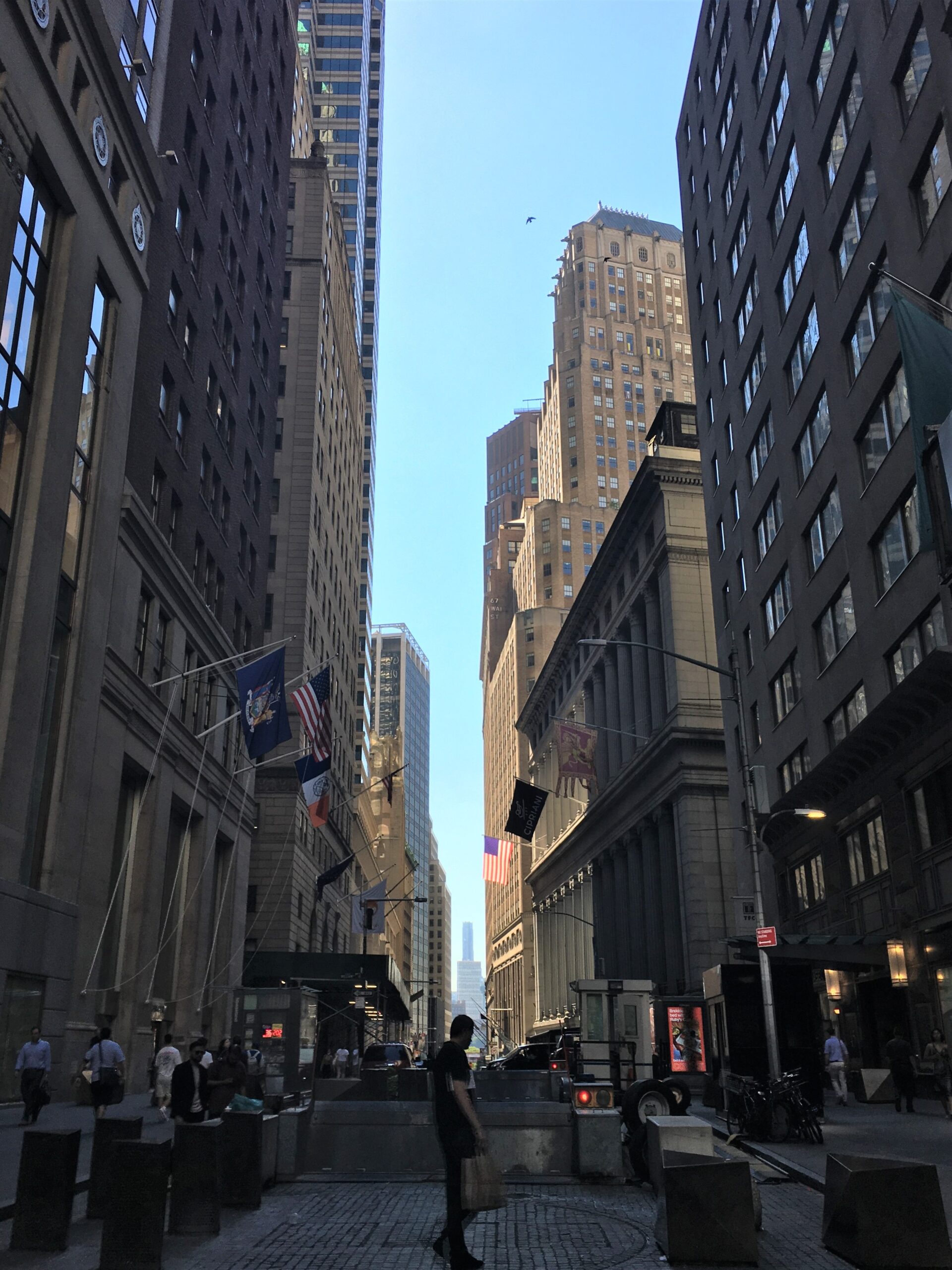
Wall Street:
One of the most fascinating facts about Wall Street is that there used to be an actual wall on the location which formed the border of the city. This wall was built by the Dutch in the 17th century to create protection for the newly formed “New Amsterdam” settlement, which is how New York was referred to back then.
The original wall, which was built to protect the Dutch settlers against Native Americans, pirates, and the British, was originally merely a wooden palisade of about 9 feet tall and 2,340 feet long.
Whether or not the street was actually named after the wall is uncertain. The Dutch gave the name so it perhaps makes more sense that the “Waalstraat” was named by the 30 Walloon families, now the southern part of Belgium and “Waal” means “Walloon” in Dutch, who embarked on the first ship “Nieu Nederlands” in 1624. The man who bought Manhattan for the Dutch was also a Walloon named “Peter Minuit.”
Whether or not the street was named after the wall or the Walloons who inhabited New Amsterdam early on remains unclear even today.
A few decades later, around halfway through the 17th century, the original wooden wall was replaced by a stone fortification. This wall was commissioned by Peter Stuyvesant, the director-general of New Netherland.
Even though slavery was pretty common in the colony throughout the 17th century and the new wall was even built by slaves, the slave market wasn’t official until December 13, 1711.
This slave market was operational on the corner of Wall and Pearl Streets from 1711 to 1762 and the city did well because of it as they charged taxes for every slave that was bought or rented on the market.
New York Stock Exchange:
Wall Street is very narrow and with our phones it was impossible to get a decent picture. Besides, the day we were there, there was a huge banner advertising a boxing match covering all the columns. Good grief! Don’t they know tourists want pictures of the building?? : )


Wonder what it looked like 200 – 300 years ago?
The first version of the New York Stock Exchange was formed in 1792.
Wall Street became an important gathering place for traders and investors to deal in securities in the 18th century. They used to do this under a buttonwood tree that was located in the area.
The first version of the New York Stock Exchange was formed in the year 1792 and was fittingly referred to as the “Buttonwood Agreement.” It already had a commission-based structure and was meant to make trading structured and fair.
There was only 1 larger financial center in the world in the 19th century
The opening of the Erie Canal resulted in New York’s businesses booming and the city became the “money capital of America,” with Wall Street as its undisputed center.
In the second half of the 19th century, agriculture was replaced by heavy industry and the financial markets became more and more important.
One of the most amazing facts about Wall Street is that it easily held its position during this period and became the second-largest financial center in the world, with only London being bigger at the time.
The most important number on Wall Street was created in 1884
In the late 19th century, the New York Stock Exchange required a better way to measure the performance of the stocks that were trading there. In 1884, Charles Dow (1851-1902) came up with a tracking system and initially started tracking just 11 stocks.
He also coined the terms “bull market,” when stocks gradually went up, and “bear market,” when stocks went down. The number is still used and now measures the performance of the 30 biggest stocks on the exchange. ~ art-facts.com
Trump Tower:
We had the same problem taking pictures of this.


The vibrancy of New York’s financial district and the style and elegance of Trump come together to create a majestic landmark property at 40 Wall Street, known as The Trump Building.
Comprised of 1.3 million square-feet of office space distributed over 72 stories, with six two-story vaults set into the bedrock foundations, this 1930 property was once the tallest building in the world. Originally named the Manhattan Company Building, it is directly across from the New York Stock Exchange, and towers over the city as a reminder of New York’s global status.
Donald J. Trump was soon in the process of making one of the great real estate deals of all time. Then the Kinson Company, a Hong Kong group, stepped up to buy it. They proved to be out of their league when it came to renovating, running and leasing out a massive New York City skyscraper. They had problems with tenants, suppliers, contractors, architects and even the owners of the land under the building, the Hinneberg family of Germany. They wanted out, and Donald J. Trump was soon in the process of making one of the great real estate deals of all time to acquire this prized building.
Mr. Trump decided to go to Germany to visit Walter Hinneberg in person, as this building deserved unmediated attention. The Hinnenberg family was relieved that someone had the integrity of their extraordinary building first and foremost in mind, and negotiations were friendly and exemplary. A deal was made, and Trump subsequently invested more than $200 million in restorations. 40 Wall Street superseded its original grandeur, and the downtown area soon experienced a renaissance. In 1998, The Trump Building was designated a landmark by the New York City Landmarks Preservation Committee. ~ 40wallstreet.com
7. The Staten Island Ferry is a free 25 minute ferry for anyone who wants to take a ride. It leaves Lower Manhattan and takes you past the Statue of Liberty (but doesn’t stop and doesn’t get very close) and over to Staten Island. Staten Island is actually one of the five boroughs of NYC (the others being the Bronx, Brooklyn, Manhattan and Queens). For those who have enquiring minds like myself, a ‘borough’ is a smaller city within the massive NYC. They have their own resources, etc. but are still considered part of NYC. Since we didn’t spend time there, other than to exit and re-enter the ferry, I found this great article on Staten Island itself if you’d like to check it out.
https://www.villagevoice.com/2018/04/06/so-why-is-staten-island-a-part-of-new-york-anyway/


Look at all the people! They seemed to be waiting in line, too!
Guess our information about having to wait 2-3 hours was correct!

and then most of us walked around the corner in the terminal and got right back on a departing boat. : )




The City has operated the Staten Island Ferry since 1905. The Ferry carries approximately 25 million passengers annually on a 5.2-mile run between the St. George Terminal in Staten Island and the Whitehall Terminal in Lower Manhattan. The Ferry runs 24 hours a day, 365 days a year. The Staten Island Ferry is the most reliable form of mass transit, with a consistent annual on-time performance record of over 92 percent during the last several years.
On a typical weekday, five boats make 117 trips, carrying approximately 75,000 passengers. During rush hours, the ferry runs on a four-boat schedule, with 15 minutes between departures. Between rush hours, boats are regularly fueled and maintenance work is performed. Terminals are cleaned around the clock and routine terminal maintenance is performed on the day shift. On weekends, three boats are used to make 96 trips across the harbor each day. The boats make over 40,000 trips annually. Ferry terminal supervisors, assigned around the clock at both Whitehall and St. George, are responsible for ensuring that the ferry operates according to its published schedule. ~ 1.nyc.gov
8. We grabbed lunch from Subway (ironic?) and sat on a bench outside the ferry terminal, before moving on. We were looking for the atlasobscura suggestion of seeing the ‘oldest fence’, built in 1771, but when we arrived, the first thing we saw was – –
9. The former Alexander Hamilton US Custom House, now housing NYC’s/Smithsonian Native American Museum. Currently home to not only the museum, but also NYC’s Archives. It took seven years to build – 1900-1907, and it is extraordinary!








We left the main room for a bit to walk around the American Indian museum.



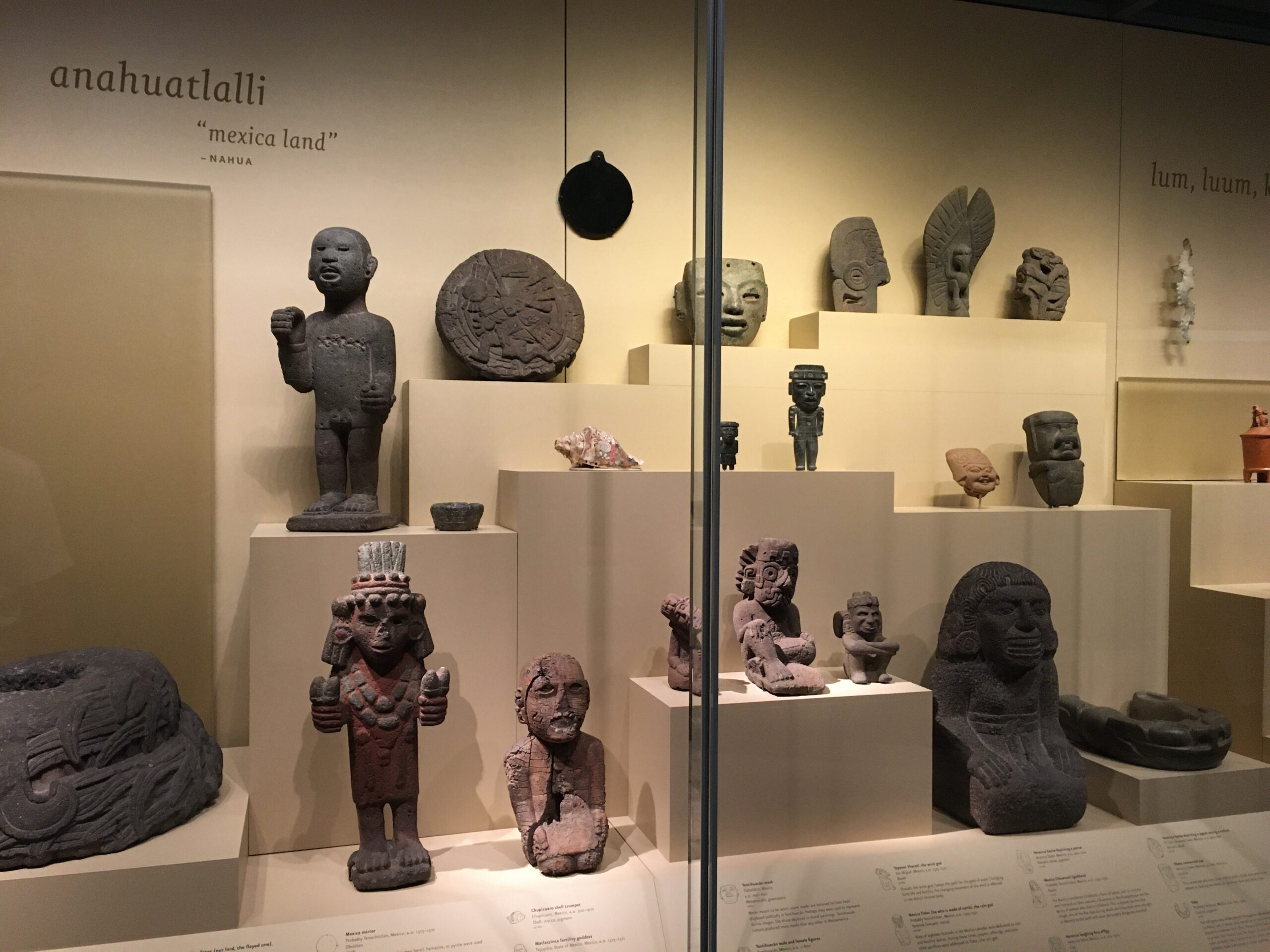

There was an entire room dedicated to the artist below.


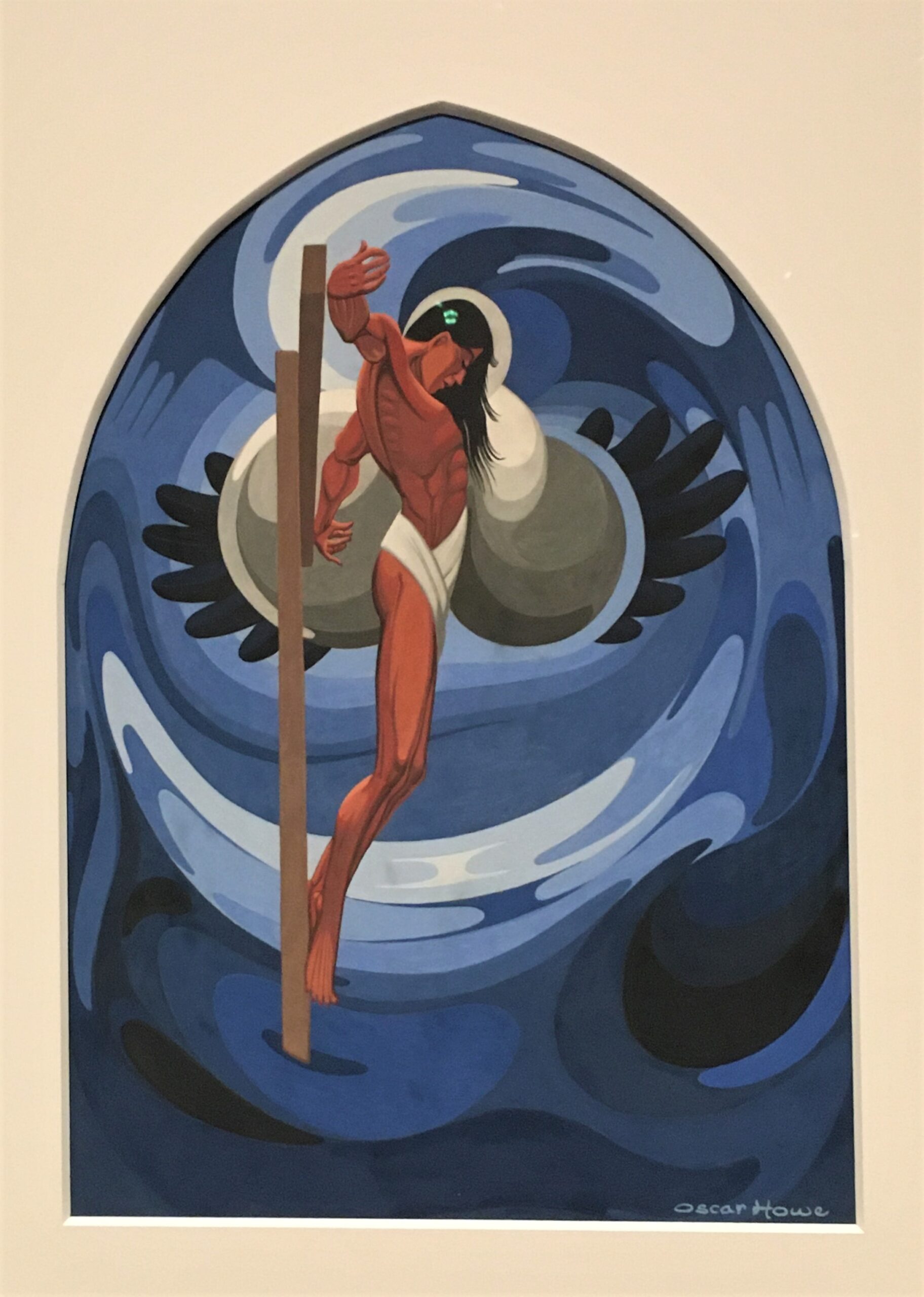

Once we finished up in there, we returned to the rotunda and read the information boards that circled the room.





There is soooo much more to this building than what we were permitted to see. If you’d like to know more, visit https://artsandculture.google.com/story/the-alexander-hamilton-u-s-custom-house-and-the-national-archives-at-new-york-city-u-s-national-archives/RwUxzCh_D5K_IA?hl=en
Once we’d toured the building and museum, we went back outside in search of . . . .
10. The Oldest Fence

Built hundreds of years ago this downtown iron barrier once protected a much despised king.
Most visitors to Bowling Green today come to see Arturo Di Modica’s imposing Charging Bull sculpture. But unnoticed in the background of their photographs is one of New York Cities most enduring and historically important landmarks: its oldest fence.
Made of wrought iron, the historic barrier was installed around Bowling Green in 1771. The history of Bowling Green itself goes back to the beginnings of the New Amsterdam colony. Situated across from the original Dutch fort it was originally used as a cattle market and parade ground, it was located at the foot of the old American Indian path which would eventually become Broadway. On March 12th, 1773 the market place was leased to three gentleman landowners for a sum of one peppercorn a year, and the ground was turned into New York’s first public park. Named Bowling Green for the sporting arena that it contained, it was designed for the “beauty and ornament…as well as for the Recreation and Delight of the inhabitants of this city.”
But the idyllic tranquility of Bowling Green would turn to mob violence in 1776. Six years earlier the British government had installed a giant statue of King George III. Weighing over 4,000 pounds it was built to celebrate the victory over the French in the Seven Years War. As relations between Britain and her colonies steadily deteriorated the statue became a focal point for anti-English protests. To combat the increasing threat of vandalism a wrought iron fence was installed to protect the monarch in 1771. On July 9th, 1776, the Declaration of Independence was read out to Washington’s troops stationed by City Hall. A mob from the Sons of Liberty rushed to Bowling Green and immediately attacked and toppled the statue of George III. Legend has it that the statue was shipped up to a foundry in Connecticut where the likeness of George III was turned into musket balls to be used against his red-coated army. Partial remains of the statue can still be found in the Museum of the City of New York.
Today Bowling Green still holds its place in history as the first public park in the City. Where once King George III looked up towards Broadway as his subjects played the gentle game of Crown Bowls in the park, there is now a fountain. Surrounded by the imposing buildings of the Alexander Hamilton customs house, the old Standard Oil headquarters and the shipping offices of Cunard and the Panama-Pacific Ocean liners, it’s a popular spot for tourists. New York’s oldest fence which once protected a king is still there though, and on closer inspection still bears the scars of that day of violence in 1776. See the fence posts were once decorated with royal crowns but on July 9th, the Sons of Liberty cut them off and the saw marks are still visible today. ~ atlastobscura.com
Then it was off to Battery Park to locate another atlasobscura suggestion . . .
11. Sea Glass Carousel in Battery Park …
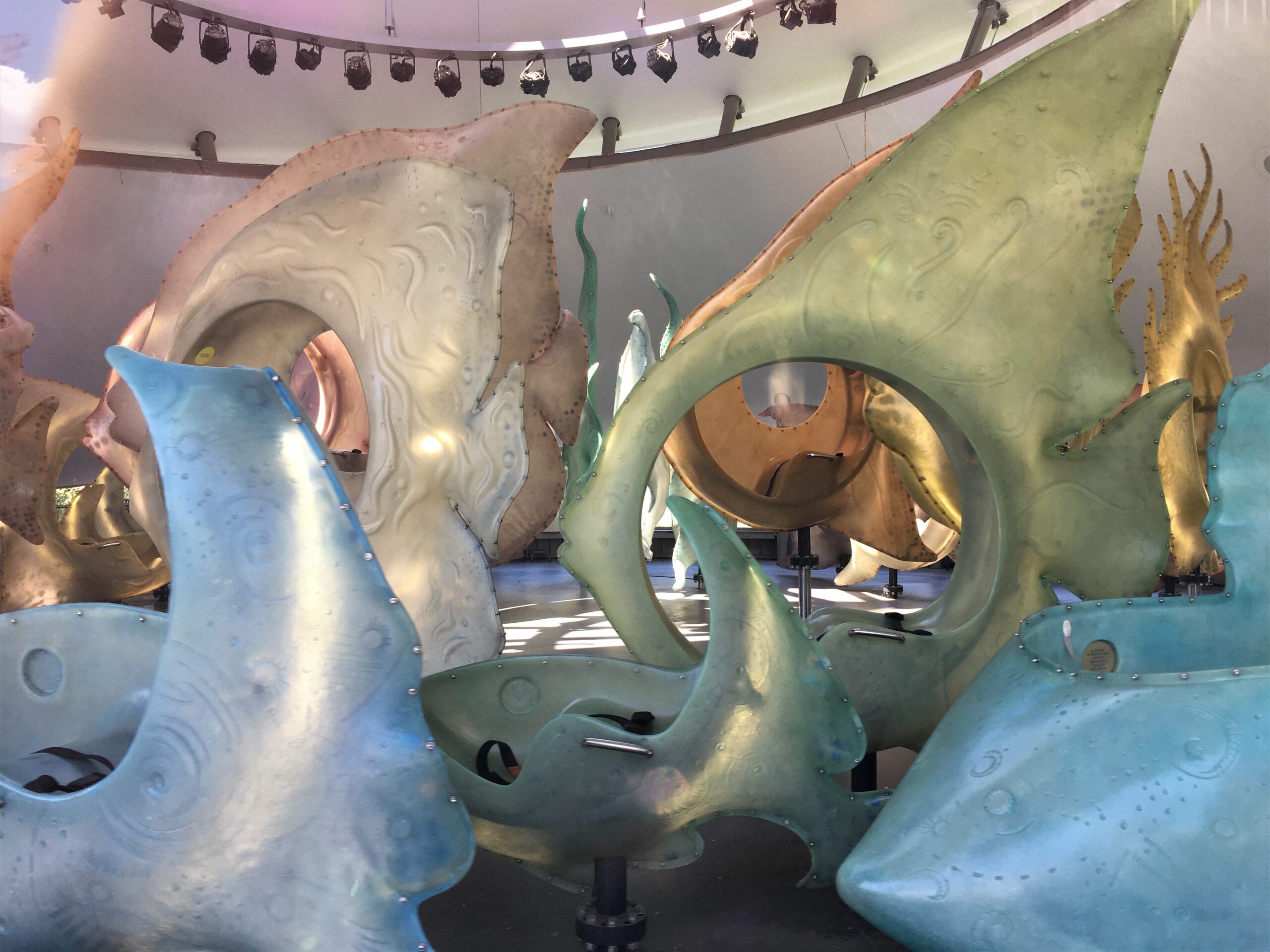
As well as the rest of the family!
How fun!

…is housed inside a glass-paneled nautilus shell that sits atop the site of the original New York Aquarium.
Opened in August 2015, the carousel is the creation of the Battery Conservancy and George Tsypin, a renowned opera and theater designer who is the man behind the staging of LaScala operas, the Sochi Olympics, and the Spiderman Broadway musical. Constructed as a public-private project, it took 10 years and several million dollars to bring the SeaGlass Carousel to life.
The SeaGlass Carousel features 30 fiberglass fish spotlighting 12 different species, while the mechanics are unique in that there’s no traditional center pole. By putting individual motors for each fish below the floor, the riders have unobstructed views while the fish both spin independently and swirl around each other as though swimming through the ocean.
Rides of the SeaGlass Carousel will also experience a changing LED light display that makes one feel as though they are truly underwater. To add to the overall experience, each fiberglass fish contains its own speakers that play aquatic sounds and music specifically composed for the ride.
Each of the fish in the carousel is modeled after an actual species ranging from tall angelfish to the much smaller clown triggerfish. No matter which you choose, it will resemble one underwater lifeform or another that can actually be found out in the ocean. ~ atlasobscura.com
Surprisingly, no one was on the carousel even though it was running, which is a shame. It’s pretty amazing with all the fish swimming around!

We passed it on the way to our next scheduled stop.
12. Charging Bull – You’d think this statue would be on Wall Street, but it’s not. And the really crazy thing? There were two lines of people wanting to take pictures with it! And the really crazy thing? The line to take pictures of the back end was much longer! Of course, there were those who didn’t care to wait. One couple (European foreigners?) stood around for a bit, then just walked right up and interfered with other people’s pictures while those in line chewed them up one side and down the other, finally forcing them to vacate the premises – without a ‘proper’ picture. They weren’t speaking English, but anyone could tell there were lines formed. They nearly caused a riot over their impatience and lack of decorum for a picture. Good grief!

The Charging Bull has become a universal symbol of the American stock market and big business. It’s also one of the most popular sights in New York City. Tourists travel from around the world to see the bronze beast, striking poses and snapping pictures in front of it.
It makes you wonder, how did it become so famous? Most people visiting don’t even know the story. Well, as a tour guide, that’s part of my job. I’m here to tell you where it all started and how the statue ended up where it is today.
Here’s everything you need to know about the Charging Bull, including the best way to experience it when you visit NYC.
Behind the Charging Bull, also called the Wall Street Bull, is a classic NYC dream story.
The creator of the Charging Bull sculpture, Arturo Di Modica, is an Italian-American artist, born in Sicily in 1941. He started sculpting as a teen and eventually moved to Florence, where he became well-known throughout Italy for his work. In the 70s, like many artists before him, he came to New York. Drawn to the city’s energy, Di Modica opened up a studio on Grand Street in modern day SoHo.
His work on the bull started after the stock market crash in 1987. Di Modica felt he owed something to Americans for accepting him all those years earlier and supporting his career as a sculptor.
Di Modica paid $360,000 of his own money in order to build Charging Bull. His goal was to inspire people to carry on through hard times and celebrate the perseverance of the American business professional. The bull was chosen to represent the “bull” (or rising) market and thriving economy — something everybody was fighting for after the crash.
The hefty sculpture weighs over 7,000 pounds and stands 11 feet tall. When the time came to display his grand artwork, Di Modica drove the bull into Manhattan on the back of a flatbed truck and illegally (guerilla-art style) placed the sculpture outside the New York Stock Exchange.
The date was Dec. 15, 1989, right in the middle of the holiday season. Di Modica thought the bull would fit perfectly under the giant Christmas Tree on Broad Street as a kind of gift to New Yorkers.
While it was meant to be a symbol of prosperity, members of the New York Stock Exchange did not take kindly to the free gift. The police department was called and, later that same day, the Charging Bull was taken away to an impound lot.
Even though it only lived a short life in front of the stock exchange, locals fell in love with the bull and demanded he be returned to the city. The New York Department of Parks and Recreation complied, placing the statue at its new location, two blocks from the New York Stock Exchange, and rededicated the Charging Bull on Dec. 21, 1989. ~ thewallstreetexperience.com
13. 9/11 Memorial (we’ll do the museum in a bit). First, I want to talk about the Sphere we found as we walked around the Memorial. The Memorial is the outdoor part. The Museum is the indoor part. The Memorial is free and open to all. The Museum you have to purchase timed tickets. So here’s the story of The Sphere:
“THE SPHERE”BY FRITZ Koenig was originally designed as a work of art that was situated between the Twin Towers in Manhattan in 1971.


As you can see by our picture, The Sphere has been neglected of late. Bushes and weeds have grown up around it, and no one seems to pay any attention to it. We happen to think it’s an astounding surviving witness to what happened when the towers fell.
The work was inspired by the Kaaba at the Grand Mosque of Mecca and was meant to symbolize peaceful world trade. After the September 11 attack in 2001, the sphere miraculously remained mostly intact, with only minor damage.
After the attacks the sculpture was stored at JFK Airport. Koenig paired up with director Percy Adlon to create a film entitled Koenigs Kugel explaining the creation and history of the sculpture. On March 11th, 2002 The Sphere was relocated to Battery Park and is now recognized as a monument of the victims of 9/11 and is meant to represent America’s strength and resiliency.
In December of 2013, it was moved around 550 feet from where it was originally relocated to a place closer to Castle Clinton to accommodate renovations that were going on at the time. On July 22, 2016, the Port Authority voted to move it yet again to the newly made Liberty Park, where it’s been since September 6, 2017. ~ atlasobscura.com
I want to begin with information on the World Trade Center. It was more than just the North and South twin towers. Those are buildings #1 and #2. The entire complex had seven buildings. Much of the information directly below covers the complex. Here’s a fact that Blaine and I never knew – – The collapse of the two towers brought on the destruction of the five other buildings in the Trade Center complex, including #7, a 47-story tower that fell at 5:20pm. We knew there was an enormous amount of damage done to the surrounding buildings, but we didn’t realize there was an additional tower collapse later that same day.
If you’re interested in reading about much of what happened with the buildings, check out the following pbs site. I don’t know why it won’t let me convert it to a link like the others, but if you highlight it and right click on it, a box comes up and you can click “go to pbs” and it’ll take you right to it.
https://www.pbs.org/wgbh/americanexperience/features/newyork-destruction/#:~:text=The%20collapse%20of%20the%20two,for%20most%20of%20the%20day.
In 1939, when Europe was on the brink of another world war, a group of business and trade associations created the first World Trade Center dedicated to promoting world peace through world trade. Though just a temporary pavilion at the 1939 World’s Fair in New York City, the idea of a neutral location where world business leaders could come together to exchange ideas and products resulted in a permanent World Trade Center in lower Manhattan.
When construction on the World Trade Center began in 1966, it was one of the most ambitious projects in size and scale ever conceived.

The original World Trade Center was a 16-acre complex that housed seven buildings and the five-acre Austin J. Tobin Plaza.
The World Trade Center contained almost 10 million square feet of rentable office space. This size equaled nearly three Disneyland Parks.
In 2001, the World Trade Center housed more than 430 businesses from 28 different countries.
The World Trade Center had its own zip code: 10048. New York State government offices at the World Trade Center used the zip code 10047.
The North Tower stood over a quarter-mile tall at 1,368 feet. Its transmission tower with broadcast antennas added about 360 feet more.
The South Tower stood over a quarter-mile tall at 1,362 feet.
Each of the Twin Towers had 110 floors.
Each tower’s footprint and floors were approximately an acre in size.
On windy days, each tower could sway up to almost 12 inches side to side.
There were 43,600 windows in the Twin Towers, equating to more than 600,000 square feet of glass. It took 20 days to wash them all.
There were 198 elevators in the Twin Towers and 15 miles of elevator shafts.
The Twin Towers were among the first skyscrapers to utilize a system of local and express elevators.
Each express elevator in the Twin Towers could hold up to 55 adults. When they were installed, their motors were the largest in the world.
Construction on the World Trade Center began on August 5, 1966, but most of the work in the first two years was below street level. The Twin Towers began their vertical climb in 1968. The North Tower was completed first in December 1970, followed by the South Tower in July 1971.
More than 425,000 cubic yards of concrete were required to construct the World Trade Center, enough to pave a sidewalk from New York City to Washington, D.C.
At least seven foundries supplied more than 200,000 tons of structural steel for the construction of the World Trade Center—more steel than was used to build the Verrazzano-Narrows Bridge, the longest suspension bridge in the United States, that connects Staten Island to Brooklyn, New York.
The World Trade Center was built entirely on landfill. As a result, the site’s foundations, including those of the Twin Towers, had to extend down to bedrock about 70 feet below street level.
During construction, workers removed more than one million cubic yards of soil and rock from the site. New York City used this landfill to help build Battery Park City, a neighborhood directly west of the World Trade Center.
The South Tower Observation Deck was composed of an indoor observatory on the 107th floor of the South Tower and an outdoor viewing platform atop the tower’s roof. At 1,377 feet above street level, the outdoor viewing platform was the highest in the world when it opened in December 1975.
On average, the South Tower Observation Deck attracted 1.8 million visitors per year.
From the opening day of the South Tower Observation Deck in December 1975 through close of business on the night of September 10, 2001, more than 46.3 million visitors experienced the views from the tower’s summit.
On a clear day, one could see for about 45 miles in each direction from the South Tower Observation Deck.
The Vista International Hotel at 3 World Trade Center, which later became the New York Marriott World Trade Center hotel, opened in 1981. It was the first hotel to be built below Canal Street in 145 years.
The Vista International Hotel was badly damaged in the February 26, 1993 terrorist bombing, necessitating major repairs. It reopened on November 1, 1994. The building was later destroyed in the collapse of the Twin Towers.
The World Trade Center complex had more than 20 different food and drink vendors, capable of feeding a population of 150,000 each day. Many corporate tenants also had their own full-service kitchens to cater to employees and clients.
In 2001, the restaurant Windows on the World, which also operated two subsidiary restaurants—Wild Blue and the Greatest Bar on Earth—employed around 450 people who spoke more than 60 different languages. These dining places were located at the top of the North Tower.
High-wire walker Philippe Petit amazed New Yorkers by traversing a 131-foot-long cable between the Twin Towers, 1,350 feet above the Plaza. Going back and forth several times, he performed the act without a net on August 7, 1974.
On July 22, 1975, Owen Quinn performed the first parachute jump at the World Trade Center from the top of the North Tower. Quinn’s jump was unauthorized. At least four other people parachuted off the Twin Towers between 1980 and 1999.
On May 26, 1977, toymaker and mountain climber George Willig scaled the entirety of the South Tower’s facade. Through this act, Willig earned the nickname: the human fly. ~ 911memorial.org
I could write an entire Special Edition or two about the memorial and museum, but I’m not going to. The loss of life (2,753 at the WTC) is shocking of course (13,000-15,000 were able to evacuate), but other things were also lost – things most of us never even knew about or considered. This website offers a list of those things if you’d like to take a look: https://www.cbc.ca/news/world/9-11-anniversary-what-was-lost-in-the-damage-1.1123528
We thought they did a wonderful job with the selection of the design for the memorial. Here’s how it happened:
Located on eight acres of the 16-acre World Trade Center complex, the 9/11 Memorial is a place of remembrance and contemplation within the bustle of lower Manhattan.
In April 2003, the Lower Manhattan Development Corporation—established to oversee the revitalization of the downtown area after 9/11—launched an international competition to choose a design for a permanent memorial at the World Trade Center site. The competition was open to adults 18 years or older, without regard for nationality or professional accreditation, and yielded 5,201 submissions from 63 countries. Entries were judged by a 13-person jury that looked for designs that honored the victims, spoke to the needs of families who had lost loved ones, and provided a space for healing and reflection.
In January 2004, the design submitted by architect Michael Arad and landscape architect Peter Walker, Reflecting Absence, was chosen as the winning entry. Their design features twin waterfall pools surrounded by bronze parapets that list the names of the victims of the 9/11 attacks and the 1993 World Trade Center bombing. The pools are set within a plaza where more than 400 swamp white oak trees grow.
The Memorial opened on September 11, 2011, 10 years after the 9/11 attacks.
The focal points of the Memorial are two pools, each nearly an acre in size, that sit in the footprints of the former North and South Towers. The pools contain the largest manmade waterfalls in North America, each descending 30 feet into a square basin. From there, the water in each pool drops another 20 feet and disappears into a smaller, central void.
According to the architect, Michael Arad, the pools represent “absence made visible.” Although water flows into the voids, they can never be filled. The sound of the cascading water makes the pools a place of tranquility and contemplation separate from the bustling noises of the city. ~ 911memorial.org
Mr. Arad is an Israeli-American who resides in Queens. Considering all the submissions they received, I’m really glad it was a local unknown who won. 😊





They put these up beside the names every year on their birthday.

We’ll talk about that soon.
Because the memorial is so large, it was impossible for us to take a picture of the entire thing, so once again, I borrowed an internet photo.

14. Double Check – This next piece, along with an internet picture, is added as a sort of afterthought. When I revisited atlasobscura for their write-ups of the places we visited, I came across this and realized we’d seen the statue, but didn’t take a picture of it. Why? Well, we already had tons of pictures, so I just skipped it because I didn’t realize its significance. There was no sign telling you what it was. So it’s a ‘fake entry’, but not really . . . 😊

but when I saw this one, I felt compelled to use it.
He’s looking in his briefcase, going through the things inside – like an old-fashioned tape recorder. : )
Zuccotti Park has always been a bustling, little oasis in downtown Manhattan. A small park lined with trees and bordered by Trinity Place and Broadway, it’s been an ideal lunch spot for office workers and tourists since the days when it was called Liberty Park, across from the old World Trade Centers. Amidst the thronging crowds, resting with his briefcase on a granite bench is an anonymous businessman. Often passed by and unnoticed, he is in fact made of bronze.
“Double Check” was sculpted by John Seward Johnson II in 1982, and placed in the park, leant to Merrill Lynch. The only concession to his being from the early 1980s is the oversized calculator and portable tape recorder lying in his open briefcase, items he was double checking before heading into one of the towering office buildings surrounding the park.
When the World Trade Centers collapsed on September 11, 2001, and downtown Manhattan was ravaged by destruction, debris, and dust, the solitary bronze businessman was as covered with concrete and dust, as everything else was that terrible day. So bewildered, lifelike and shocked did he look, the Double Check businessman was mistaken for a real person by firemen and rescue teams looking for survivors amidst the rubble. Many first responders were said to have approached this dazed, solitary man, only to startle when wiping the dust from him to find bronze underneath.
“Double Check” became an iconic memorial to the many businessmen who died in the attacks, with flowers and candles left there in the days that followed. The statue itself, dented and damaged by the falling masonry, was temporarily removed to the artist’s studio, where it was refurbished by Johnson. But the damage caused by the Twin Towers collapse he left, as a memorial.
A new plaque was added, stating, “the ‘everyman’ businessman presence in Liberty Park who before, had faded into the background amongst his human brethren, has been called ‘the survivor’….this bronze man sits again in his original site bearing scratches and bruises he sustained that day as a poignant reminder of hope and endurance for us all.”
Today, Zuccotti Park remains as popular as ever, with visitors flocking to the new Freedom Tower, 9/11 memorial and excellent museum, and the science fiction-looking Oculus transportation hub. Johnson’s anonymous businessman from the ’80s is still there, double-checking the contents of his briefcase, and still mostly overlooked by passersby. ~ atlasobscura.com
15. Oculus – It took us quite a while to figure out what ‘Oculus’ was, and truth be told, even after visiting it during our waiting time to go into the 9/11 Museum (we were an hour early), we still didn’t realize what we were visiting. It’s a gigantic, artistic building (the artist says it represents a dove leaving a child’s hands) that held a bunch of stores, and we thought it was a shopping mall. We had no idea it was also a subway station! It serves the PATH, a train established in 1962 that travels back and forth between NYC and New Jersey, as well as 11 other subway lines!

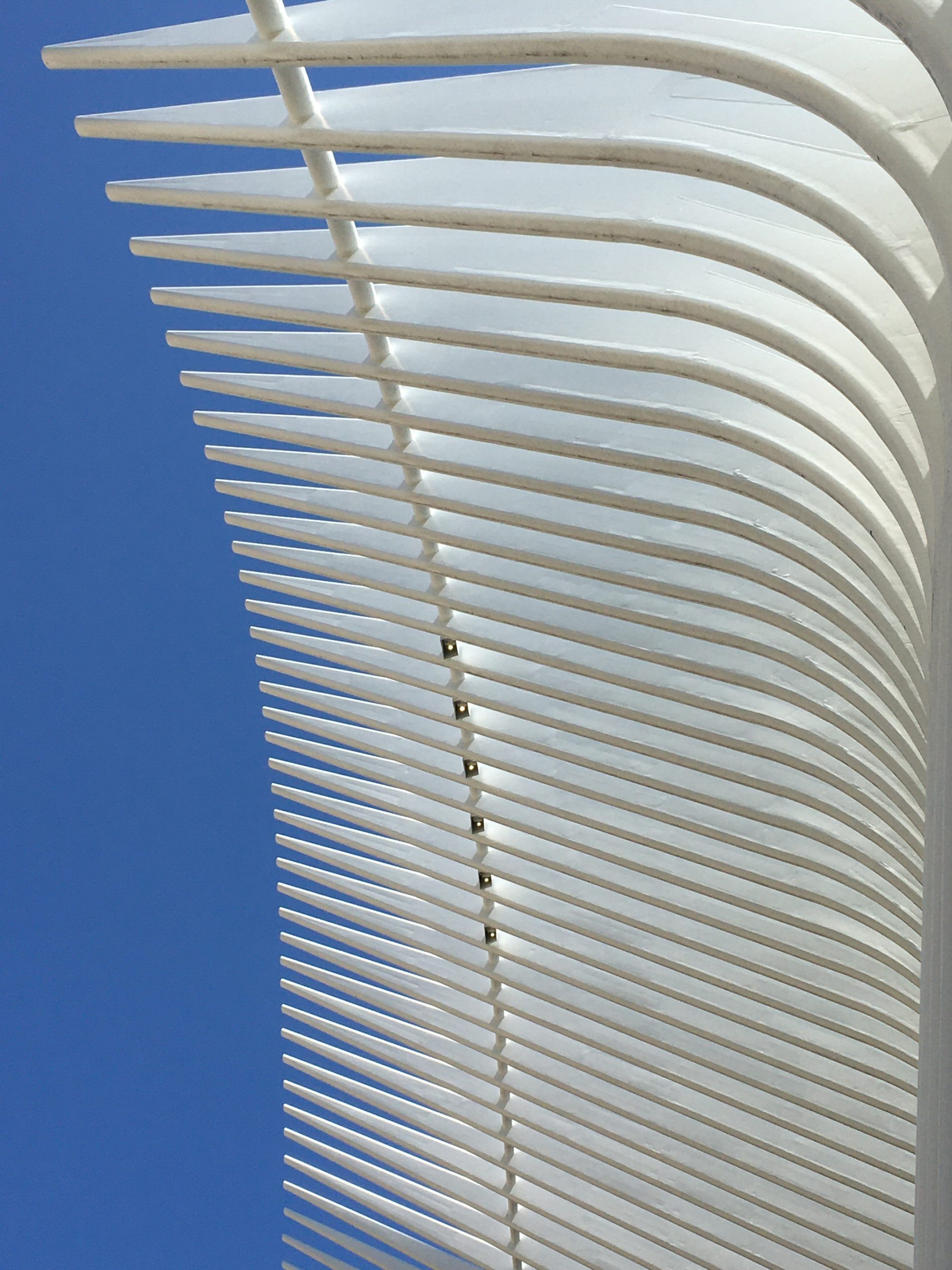
The work of rebuilding The Oculus NYC was started right after the incidents of 9/11 but the project took 14 years to be completed and opened in February of 2016, which was 7 years behind schedule to which the architect explains that it was his idea to use this time to build it for the new generation of the city.
With an estimated budget of 2 Billion when it was proposed in 2004, it ended up costing double it at 4 Billion dollars making it the most expensive train station in the world.
About 11.500 tons of steel was used in the construction of this huge structure and the steel used was so specialized that only 4 firms in the world can manufacture that, hence it was shipped specially from Italy to Brooklyn. This steel comes with a fireproof coating giving it a rough texture that could have been smoothened.
There were over 580 pieces with some elements over 30 m long proved to be very difficult to transport, from the workshop to the construction site of a 7-mile route in the dense urban area of lower Manhattan which kept the workers busy for many years and cost 3 million dollars.
The cranes used in the construction of The Oculus NYC and responsible for lifting heavy components with a height of 185ft were some of the biggest cranes ever used in the city. ~ atlasobscura.com
After the devastating September 11th attacks, plans were quickly put in place to rebuild and reimagine the World Trade Center. These plans included the idea for a transportation hub that would bring business and people back to the area — the Oculus.
By 2004, construction had begun, and 12 years later, the Oculus opened to the public. As a project with a commercial and artistic focus, the Oculus has come to represent the city’s strength and a beacon for resilience.
Many people tend to forget how much damage was really caused by 9/11. The entire World Trade Center, all seven buildings, were completely destroyed, along with the PATH train station that served millions of commuters traveling to Lower Manhattan.
When rebuilding plans were discussed, one of the first major issues to tackle was building a new station. City planners decided that the new station would be a combination transportation hub and shopping center — a place that attracted residents and tourists alike.
The name comes from the strip of windows, or skylights, along the spine of the roof. Oculus is the Latin word for “eye,” which, in architecture, refers to a round or eye-like opening with a view of the sky. Take a look up through the windows, and you’ll see Freedom Tower.
It’s an inspiring sight.
This opening also allows sunlight to pour in each morning. The angle of the windows is particularly placed so that every year on the anniversary of the attacks, the sun shines directly through the skylight and illuminates the main hall at 10:28 a.m. (the time of the collapse of the second tower). It’s called the “Way Of Light.” Calatrava positioned the building slightly tilted from the street grid in order to achieve the effect.
While the complex design was responsible for several construction delays, the building is now a regular destination for visitors to Ground Zero. ~ 911groundzero.com

Now that took some really specialized planning!


16. 9/11 Museum is where much of the story is told. The Memorial is a place of remembrance, but the museum is where you learn the story and feel and see the heartbreak. It’s a huge area, which allows people to move about without crowding, which is much more conducive to the somber atmosphere. Still, we kinda felt let down a bit. Maybe it was the fact that we we’d already been running full-tilt and hot since 5:30am and it was now after 3:00pm, and we were weary. We wanted to be really moved here, but for the most part, that didn’t happen. We felt bad about that. Still do, but putting this portion of the post together rejuvenated my heart and brought tears to my eyes a few times.
After the September 11th, 2001 terrorist attack on the World Trade Center, New Yorkers felt feelings of immense loss. Some New Yorkers were able to find healing through a symbolic representation of their faith in the form of a crossbeam unearthed at Ground Zero.
When the World Trade Center was built, the use of prefabricated parts helped bring costs and production time down. These parts, known as t-beams were bolted or welded together and formed what may remind some people of a Latin cross.
When one considerably intact t-beam was found in the debris of Ground Zero, many of the first-responders who were of the Christian faith, turned the t-beam into a makeshift shrine. During the recovery and clean-up process, Catholic mass was performed every Sunday at the cross.
After the clean-up process was complete, the cross was then moved to St. Peter’s Church across from the World Trade Center site where it became a popular tourist attraction and place of pilgrimage. When the formation of a memorial and museum dedicated to September 11th was announced, it was revealed that the cross would be added as part of the exhibit.
Objecting to this was the secular organization American Atheists, who believed that since Ground Zero was now a public space, religious symbols should be banned, especially considering the fact that victims of other faiths and nonbelief were also lost during the attack. The group’s legal challenge was dismissed by a 2nd U.S. Circuit judge who ruled that the cross was “historical in nature” and did not discriminate against any other groups.
The Cross at Ground Zero remains at the National September 11th Memorial and Museum as part of a display on how New Yorkers tried to find meaning in the disaster, alongside other symbols both religious and secular. ~ atlasobscura.com
We found the cross inside the museum, where it’s been since sometime before 2012 when the museum opened, but we weren’t permitted to take pictures where it stands in the room filled with large pictures of each of the victims.



Most (if not all) of them are marked with where they came from and many even say where they were originally. I’m amazed how they can know that, with all the carnage they had to clean up.







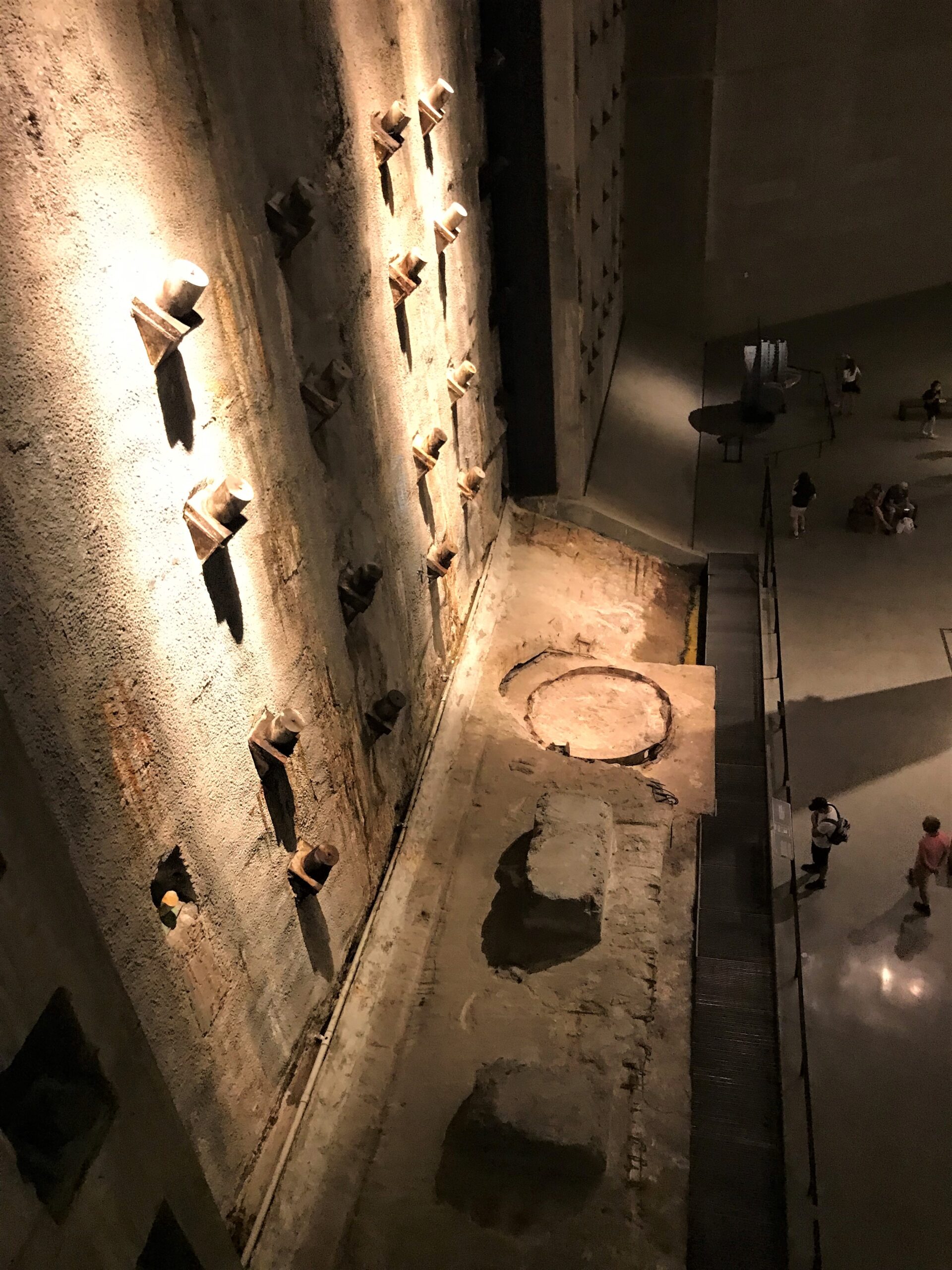





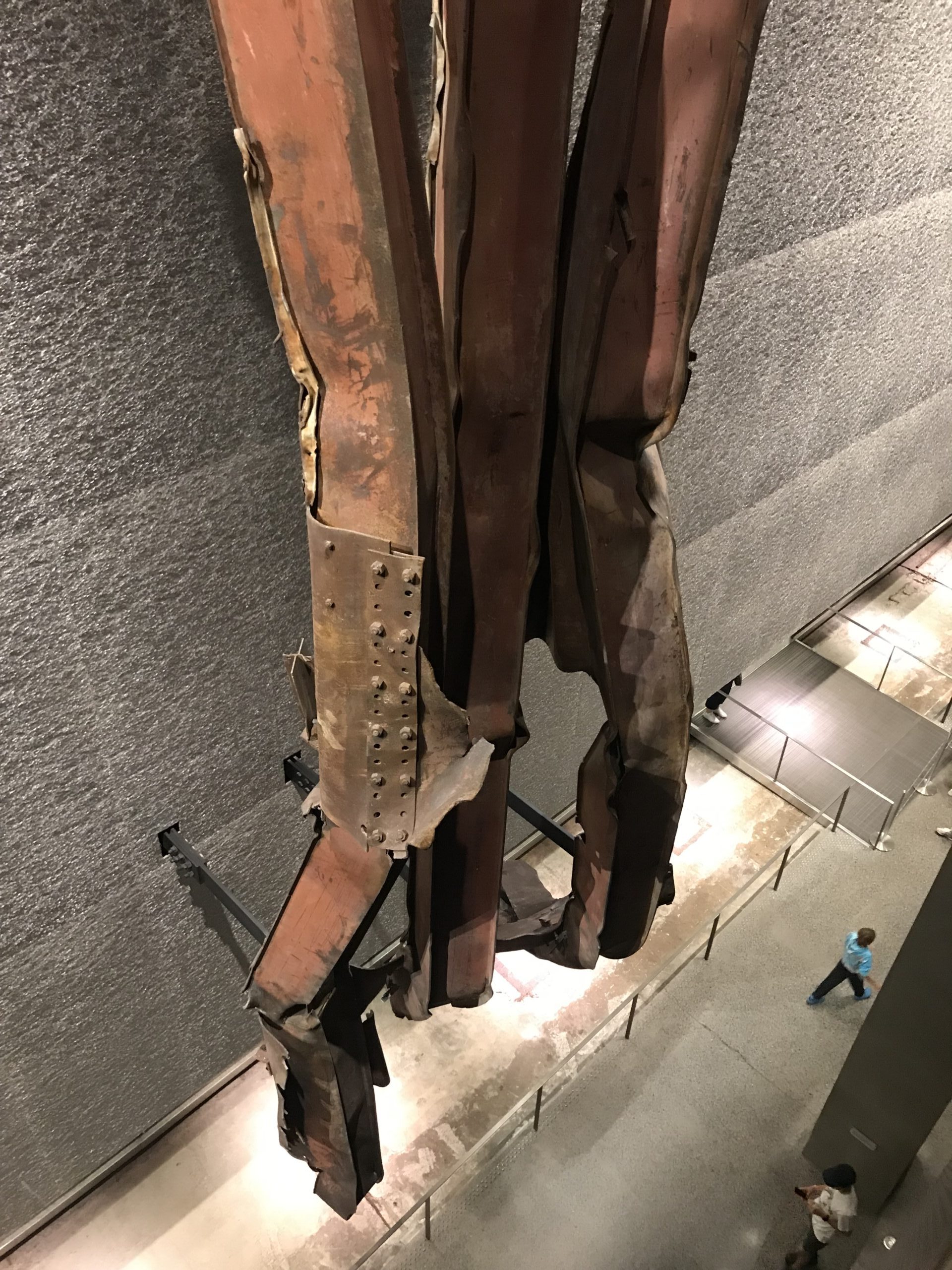

It was ripped in half at point of impact.





















They would gladly work 24 hours a day if you would let them. ~ Dr. Lisa Murphy, Veterinarian




In all, once the towers fell, there were only 23 survivors located in the debris.
Sixteen were civilians, the rest were rescue workers.








This is the last picture we took before heading out into NYC traffic.

Just like you see on TV or movies!
It’s insane! So glad Blaine wasn’t trying to drive!
17. Ghostbusters Fire Station – This was our final stop before heading to our hotel. Our sons were big fans of the original “Ghostbusters” movie when they were growing up. In fact, I even found a denim blue jumpsuit that I fabric-painted the logo on and they’d pretend to be ghostbusters. Good memories! 😊 And once again, thank you atlasobscura!
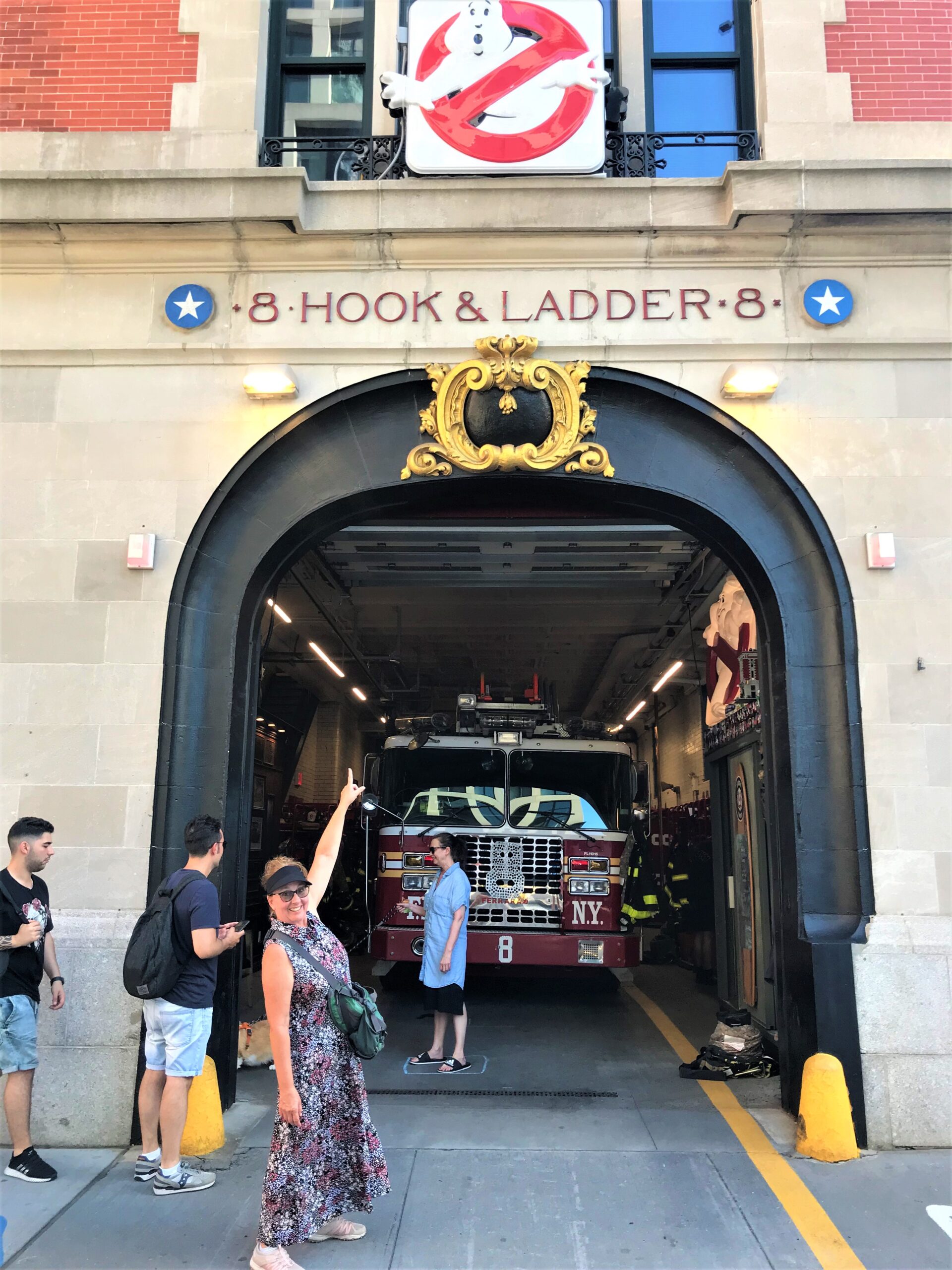

As you walk down north Moore Street in lower Manhattan, you may find you have the sudden urge to turn to someone on the street and say “I am the keymaster,” to which they must by all rights of man and law reply “I am the gatekeeper.”
New York is filled with famous movie locations, but few are as iconic or nostalgic—at least to those who grew up in the 1980s—as the firehouse from the 1984 classic Ghostbusters. The 1903 Beaux-Arts building, home to the real-life Hook & Ladder Company 8, was used for the exterior scenes of the fictional firehouse where Peter, Ray, Egon, and Winston set up their ghostbusting operations. Although the Ghostbusters logo sign might not hang from the front of the building like in the movie, it’s still plainly recognizable today as the Ghostbusters firehouse.
Besides Ghostbusters, the building’s memorable facade has also been featured in other movies and TV shows. It appeared in the 2016 Ghostbusters reboot and it was used for the external shots of the firehouse where Kramer worked in an episode of Seinfeld.
The building was gutted and underwent a major renovation from 2016 to 2018 to update the living quarters, locker rooms, kitchen, and roof. The floor of the century-old building was actually in danger of collapsing from the weight of the fire vehicles stored inside. Following the restoration, the building looks relatively the same, although the red garage door is now noticeably different, with multiple panes of glass.
If the firefighters of Hook & Ladder 8, who were among the very first responders to the World Trade Center on September 11, are available to give you a tour of the inside, you can take a look at the collection of melted clocks and phones they’ve accumulated from the various fires they’ve put out. Just remember that Hook & Ladder Company 8 is a fully functional firehouse, so be respectful of their space and time, and try not to yell “Don’t cross the streams!” too loudly. ~ atlasobscura.com
18. Free dinner! We couldn’t get to our hotel fast enough. We’d planned on dinner somewhere, but we were just too hot and tired, so we thought we’d rest a bit, then head back out for food. Lo and behold!! We walked in and just inside the door was a wonderful spread of food – veggie platter, salad, cheese and crackers, a large bowl of strawberries, black berries and red raspberries, cookies, and a large crock full of chicken soup! They also had water flavored with orange slices. Oh. My! Just exactly what we needed! And it was free! Turns out, they do this every Wednesday evening. We were soooo blessed to be here on a Wednesday! After we ate, we took an elevator to the top to look out over our little portion of the city.


We walked 12-13 miles today. Why didn’t we take transportation? Because walking was usually just as fast – or faster than taking the bus.
Tomorrow we’ll do it all over again!
